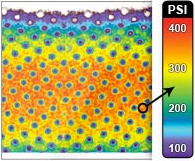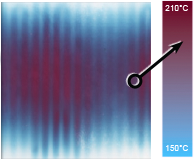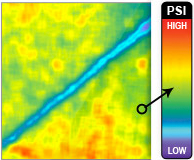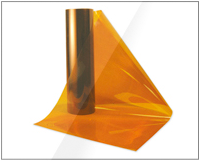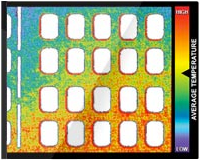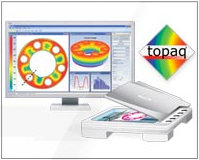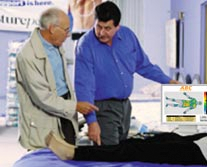Estimating the Shock-Absorbing Ability of Protector Materials by Use of Pressure Films
Elzbieta Maklewska, Izabella Krucinska*, Gerard E. Mayers**
Institute of Knitting Techniques and Technologies TRICOTEXTIL ul. Piotrkowska 272, Lódz, Poland
*Technical University of Lódz, Department of Textile Metrology, ul. Zeromskiego 116, Lódz, Poland
**Sensor Products Company in East Hanover, NJ, USA
Abstract
One of the most important features of the special clothing used in such sports as hockey, horse riding, football, combat sports, motorcycling and martial arts is protection against injuries due to blows and falls. Impact protectors inserted in clothing and protection equipment should fulfil this function. Methods for estimating various materials’ ability to dampen the stroke energy have been described by the authors in previous papers. Two different testing methods were used while carrying out investigations into dampening impact blows. A special tactile pressure sensor film was used for further assessment and investigation of the impact force, which is exerted by one of the impactor of the stands at contact with the specimen. The results obtained by example testing are discussed, and the advantages and disadvantages of this method emphasised.
Key words: shock absorbing, impact protectors, pressure sensor film.Introduction
Sports activities, especially horse riding, football, hockey, fighting skills, fencing, snowboarding, and motorcycling, involve the risk of injuries as the effect of impacts [1-4]. Special clothing and clothing elements are recommended to protect people playing these sports against blows. Impact protectors, which in their structure include layers of materials damping the energy of impacts, are essential parts of such clothing [5-7]. The importance of protection while practising sport and the necessity of large-scale prevention of impuries have been confirmed by the European Standardisation Committee (CEN TC162 WG9 and WG11) while devising standards concerning the requirements and testing methods for the sportswear and equipment used in these sports.
Two different testing methods for estimating the energy dampening abilities of the materials used in impact protectors were presented in paper [10]. The first was a static test, carried out on the basis of standard PN-87 C-04289 [8] with the use of a Instron tensile tester. The second was a dynamic test with the use of a pendulum machine constructed specially for the purposes of evaluating materials subjected to protect impact forces. Comparing the results of both tests, it was demonstrated that the evaluation of the energy absorption ability established in static conditions was confirmed by dynamic tests.
The European Standards mentioned above, which cover impact protectors used in sportswear test methods, describe the requirements for measuring stands designed for estimating a material’s ability to damp the energy from blows. Such a test stand, the Drop Tower, has been designed and built at the TRICOTEXTIL Institute of Knitting Techniques and Technologies (ITTD). A detailed description of the Drop Tower, as well as preliminary test results, was presented in [10].
This paper describes the evaluation of the shock-absorbing ability of speciality materials, namely adhesive bonded nonwoven coir mats, by means of another two test methods.Both methods used the Drop Tower at the same time, but while the first method was based on the measuring systems of the Drop Tower, the second method was based on the application of special tactile pressure sensor films (TPSFs).
Materials
Two samples of adhesive bonded coir mats were prepared. Coir mats are proposed as an alternative material for application in impact protectors.
Commercially available water dispersion of ethyl vinyl acetate (EVA) was used as an agent to bind the individual fibres of the nonwoven. The dispersion was used in a ratio of 50% EVA to 50% coir. This kind of binding agent has high damping ability, and can be applied instead of the sticky natural latex of high elasticity which was hitherto used for binding material fibres in nonwoven. The studies on coir/Eva nonwoven are presented in [9], and the samples are described in Table 1.

Table 1 - Description of samples.
Methods
The aim of this study was to determine the cushioning properties of the samples tested by two methods: performing the impact testing with the Drop Tower measuring devices, and using special tactile pressure sensor films (TPSF).
Method 1: performing impact testing
The measuring stand of the Drop Tower type was used in the first testing method. The stand enables the material’s dynamic damping ability to be investigated during a vertical drop of a free-falling impactor on a sample placed on an anvil. During impact, the impactor acceleration and the sample deflection were recorded. The impactor acceleration enables the force response of the sample to be determined according to the equation F = ma, where m is the impactor mass and a is the deceleration (negative acceleration) of the impactor. This force, in accordance with Newton’s third law of action and reaction, is equal to the force transmitted onto the anvil through the sample, which is recognised as the hypothetical impact protector. It is especially important to gauge the impact force on the anvil, as it simulates a part of the human body. The value of this force is the measure of the tested material’s ability to protect against an impact.
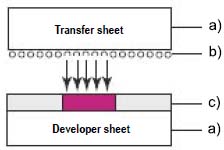
Figure 1. Cross sectional view of Pressurex Film; (4 mils = about 0.1 mm) [13]; a - substrate (polyster film) 4 mils, b - microcapsule layer, c - colour developing layer.
Method 2: Estimation of shock-absorbing ability by using TPSF
To estimate the contact pressure information during the impact test on the Drop Tower, a special commercially-available tactile pressure sensor film (TPSF), known as Pressurex®, was placed between the sample tested and the anvil. The TPSF technique can be used in any situation where two components contact or impact with a normal (perpendicular) vector of force. The force distribution and the magnitude can be determined. Only the forces of pressure values, which exceed the minimum measuring range of the pressure film, are recorded. Microcapsules embedded in the film burst at precise pressure levels and release chemical contents, which then interact with a developer component to produce visible colour changes, namely different shades of red (Figure 1). This quantifiable colour change is directly proportional to the amount of the pressure applied. The colour change of the film can be visually compared to a colour calibration chart, to obtain an approximate indication of the magnitude of pressure (Figure 2).

Figure 2. The colour of Pressurex sensor film can be visually compared by the colour correlation chart; (pressure range 13 – 30 kPa) [13].
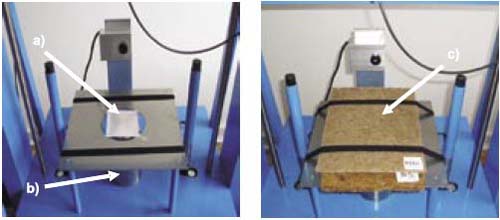
Figure 3. Performing impact testing with Drop Tower stand: a) Pressurex film, b) anvil, c) tested sample.
A more sophisticated and accurate technique for analysing and interpreting TPSF is by using an optical imaging tool. This tool is the Topaq pressure analysis system, which consists of Windows-based software and a specially calibrated scanner. The film test results gives information about the pressure distribution and magnitude, as well as the summary of forces caused by pressure which is included in the measuring range of the TPSF used.

Table 2. Results of impact tests from the Drop Tower Stand measuring systems, and results according to Topaq software analysis.
Impact Test Results
Two experiments on the Drop Tower measuring machine were conducted with simultaneous use of the Pressurex® film. The film was affixed to the anvil under the test sample (Figure 3). In this study, a medium-pressure film with a pressure range of 1400-7100 p.s.i. (1-5 kPa) was used, so only pressures in excess of 8.9 MPa were recorded. The raw imprints of impacts are presented in Figure 4. The results of the impact tests obtained by the use of the Drop Tower measuring systems are presented in Table 2.
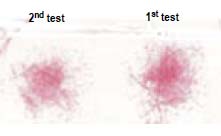
Figure 4. Raw imprints of impacts.
The test data (i.e. the raw imprints of the impacts) was returned to the producer of the Pressurex film for optical imaging and analysis. This analysis revealed the areas of highest impact pressure as transmitted through the samples tested. A pseudo-colouring of the scanned 2D and 3D image showed, in the yellow-orange area, where the values of the impact force measured were greatest (Figure 5).

Figure 5. The 2D and 3D rendering of the data recorded on the TPSF high film, 2D - a) and b); areas of highest pressure appear as orange and yellow in this image. Note: this figure is presented in colour in the internet edition of the journal (www.fibtex.lodz.pl).
Other analysis features, besides the 2D and 3D rendering options (Figure 5) are the histogram chart (Figure 6) and the pressure profile line scan (Figure 7). The pressure profile line scan, thanks to the narrow segment of the test scanned, enables estimation of the force pressure values presented in Table 2.

Figure 6. A histogram analysis of the pressure and pressure statistic. The green colour of the impact area shows where the pressure values are within the measuring range of the pressure film. Areas exceeding the chosen maximum value appear as red. Note: this figure is presented in colour in the internet issue of the journal. Note: this figure is presented in colour in the internet edition of the journal (www.fibtex.lodz.pl).

Figure 7. The line-scan reflects the amount and location of pressure along a user-defined line. Note: this figure is presented in colour in the internet edition of the journal (www.fibtex.lodz.pl).
Summary
In the current study, the values of the forces transmitted to the tested samples while carrying out impact tests were compared. The testing results were obtained by two methods: by use of the Drop Tower stand (force FD) and by use of TPSF (force FT). During tests with the use of TPSF, only forces that caused pressure values between 1400-7100 p.s.i. (the green area in Figure 4) were transformed by the analysing system. The values of forces which caused pressure above and below this range were not recorded. This fact may explain why the force values obtained with TPSF testing (FT) are lower than the force values obtained from testing with the Drop Tower measuring systems (FP).
According to the results obtained by both test methods, the lower force values for N3H220 compared with N3 indicate that the shock-absorbing ability is higher for N3H220. In addition, the pressure (force) distribution is more uniform for N3H220.
Conclusions
The measuring stand (Drop Tower) designed for estimating and analysing the shock-absorbing ability of materials destined for impact protectors is a very valuable research tool. It enables both a qualitativeand a quantitative analysis of the phenomenon of kinetic energy absorption of the materials tested. However, it does not provide any information about pressure (force) distribution under the protector during impact. The high values of this force when concentrated on a small area of the human body are particularly dangerous, and can cause injury and damage to the body.
The Pressurex sensor film used during impact testing gives the possibility of determining force (pressure) distribution transmitted under the impact protectors being tested. With relative ease, the local impact force and average pressure caused by the kinetic impact energies, can be assessed visually. This additional information obtained due to the application of Pressurex film can help in preparing appropriate material composition and the construction of impact protectors to diminish the risk of injury during accidents.
The preliminary tests carried out do not allow the accuracy of the TPSF method to be estimated, especially as the evaluation procedure used by the TPSF manufactories is not known exactly (e.g. the averaging method used for pressure). Considering the calibration of the Drop Tower measuring systems, which we carried out, we can assume that the accuracy of the force measurements by TPSF is worse than 20%, and that the force magnitude accuracy of 4% given by the producer is doubtful. A more precise estimation of this problem requires additional tests.
When implemented as a means of estimating force distribution, TPSF can support the overall results of the Drop Tower test stand measuring systems excellently, providing additional information to the total dynamic characteristic (the cushioning properties) of the tested material about the force distribution under the tested sample.
Acknowledgment
This research work was supported by the Committee of Scientific Research (KBN). Grant No. 3 T 08E 026 26.REFERENCES
- Garlicki, J. et al.: ‘Sport trauma at the verge of the Third Millennium’, Sport Medicine 17(2001) 3-4.
- Radzioch, W. et al.: ‘Analysis of sport injuries of upper limbs in materials of sports-and-medical treatment centre in Czestochowa’, Sport Medicine 15(1999)6,No 95.
- Gibson T. ‘Sports Injuries’, Baillieres Clin Rheumatol, 1987 Dec., 1930, 583-600.
- European Experimental Vehicles Committee, Report on Motorcycle Safety. Dec. 1993 Report of Ad Hoc Group.
- Ellis T.H., ’Sports Protective Equipment’, Prim Care, Dec. 1991, 18940, 888-921.
- Mills N.J., Gilchrist A. ‘Body Protectors for Horse-Riders’, International Research Council on Biokinetic of Impacts, Conference Proceedings, Sept.1990, Lyons, France
- Otte D., Middelhauve V. ‘Research Accident Unit Quantification of Protective Effects of Special Synthetic Protectors in Clothing for Motorcyclists’, IRCOBI Conference Proceedings, 1987, Birmingham
- Maklewska E., Demus J., Krucinska I., Matyjewski M., ’Comparison Analysis of Shock-Absorbing Properties of Materials Used in Impact Protectors’, F&TEE No. 1(36)2002 p. 81-84.
- PN-87 C-04289: “Rubber. Evaluation of relative absorption in conditions of compression stresses.”
- Maklewska E., Tarnowski W., Krucinska I., Demus J., ‘New Measuring Stand for Estimating a Material’s Ability to Damp the Energy of Impact Strokes.’; F&TEE No 3 (47) 2004 p. 48-52.
- Maklewska, E., Krucinska, I.(2004), ‘Study On The Structure Of Nonwovens With High Shock-Absorbing Ability’, 2nd International Textile, Clothing & Design Conference “Magic World Of Textiles”, October 3rd to 6th 2004, Dubrovnik, Croatia.
- Nawrocki A., Demus J., Maklewska E., Mielicka E., ‘Clothing Protecting Brachial Plexus of Motorcycle Rider during Collision’, F&TEE, vol. 12, No 3(47), 2004 p. 53-57.
- Tactile Pressure Experts – SPI - Sensor Products Inc., USA Technical Information; www.sensorprod.com.




